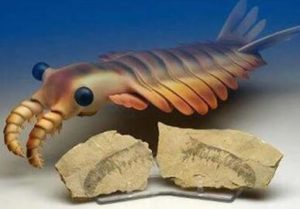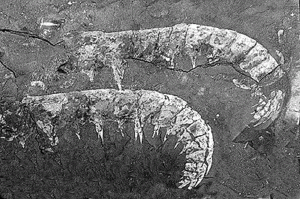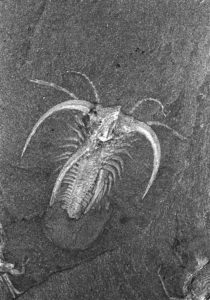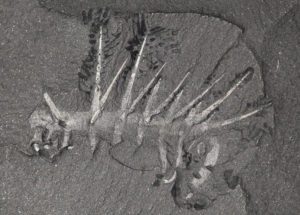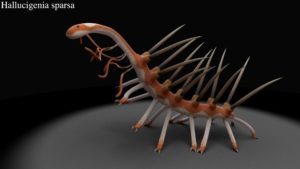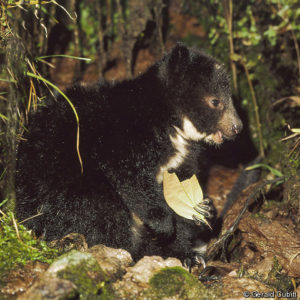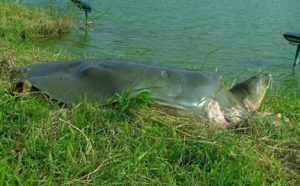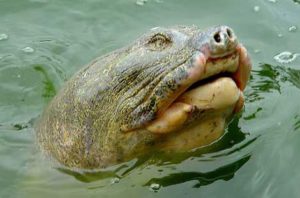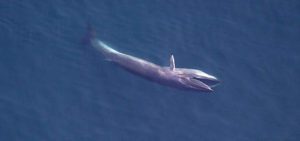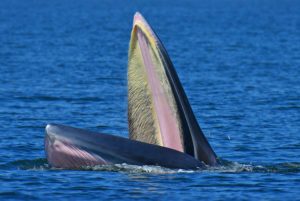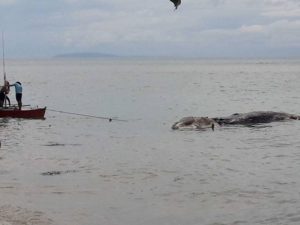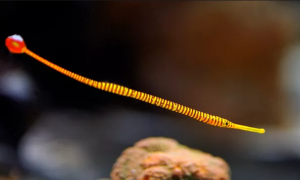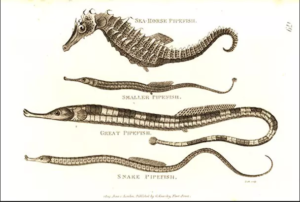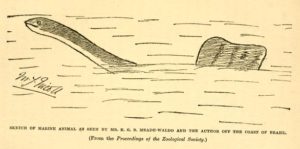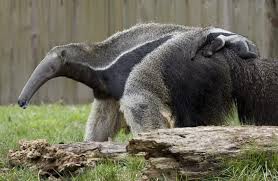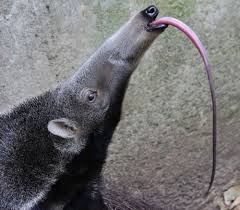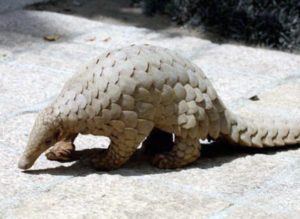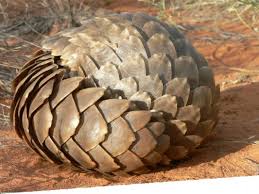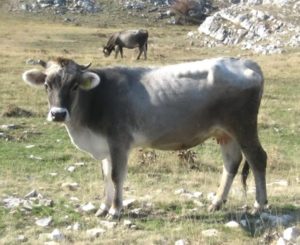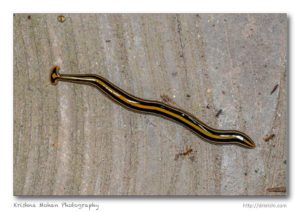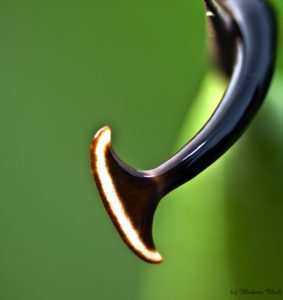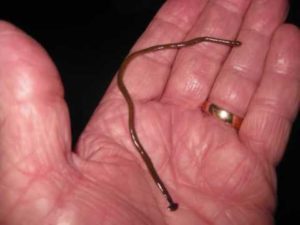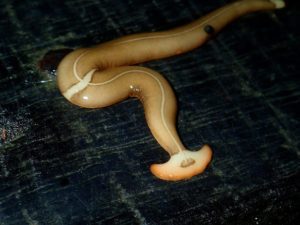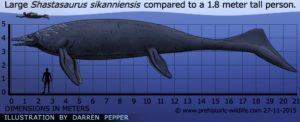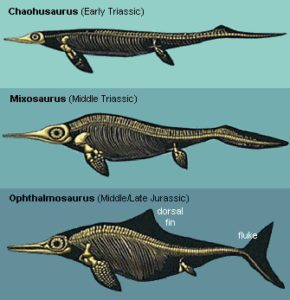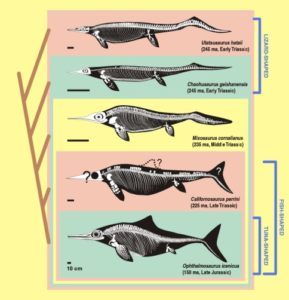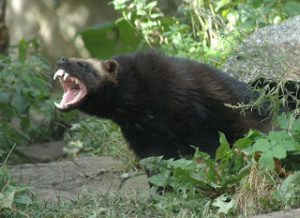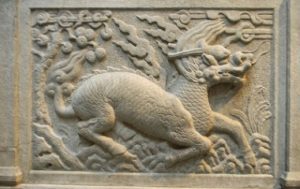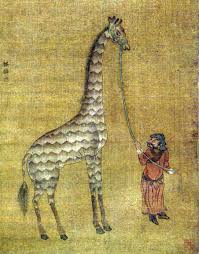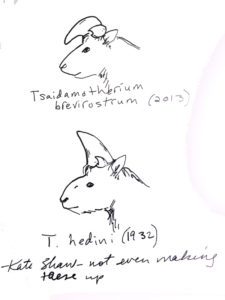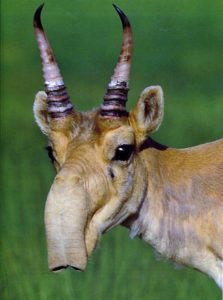Podcast: Play in new window | Download (Duration: 19:37 — 15.5MB)
This week we’ll learn about birds that are mysterious in one way or another. If you need more bird knowledge, check out the awesome Casual Birder Podcast, especially this week’s episode with a guest spot by me about indigo buntings!
Lots of pictures for this one, hoo boy.
The Nechisar nightjar wing. It’s all we’ve got:
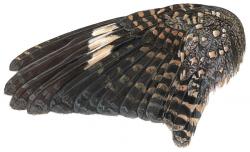
Junkin’s warbler, a mystery bird whose identity was solved by SCIENCE:
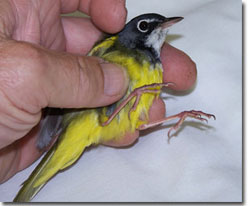
The lovely blue-eyed ground dove:
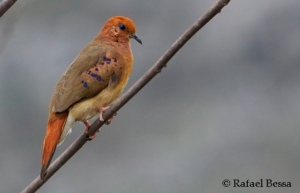
The two tapestries depicting a mystery bird:


Close-ups of the mystery bird from the tapestries:
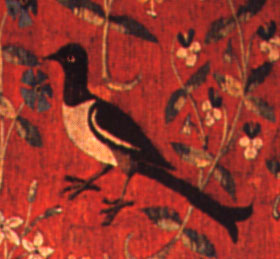
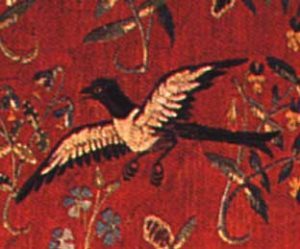
A black grouse, that may have inspired the tapestry birds:
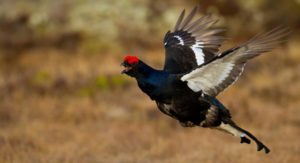
A wandering albatross, which has the largest wingspan of any living bird known and will CURSE YOU:

The bee hummingbird, smallest living bird known, will only give tiny curses if it’s really mad:
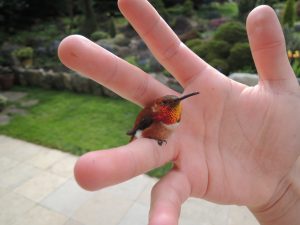
An olive-backed sunbird:

A hermit hawkmoth, not even kidding that this thing looks and acts like a hummingbird:

The cahow, or Bermuda petrel:

Show transcript:
Welcome to Strange Animals Podcast. I’m your host, Kate Shaw.
On the same day this episode is released, the Casual Birder Podcast is releasing an episode about finches with a contribution from me. If you haven’t tried the Casual Birder Podcast, it’s a great show about birds and birding that I highly recommend. It’s 100% family friendly, the host’s voice is pleasant and calming, and it’s often funny and always interesting. I’ve got a link in the show notes, so head on over and try the finch episode, where you can hear me dropping some knowledge about the indigo bunting. And for any new listeners who came here from the Casual Birder Podcast, welcome! We’ve got a great episode this week about birds that are associated with a mystery in one way or another.
We’ll start in Ethiopia, specifically the Nechisar National Park in the Great Rift Valley. In 1990, a team of researchers was surveying a remote section of grassland in the park to see what animals lived there. One of the things they found was a dead bird, not in the field but on a dirt road, where it had been killed by a car. It was a type of nightjar, but the bird experts associated with the survey didn’t recognize it. The problem was, though, that the bird was pretty mangled and rotten. Only one wing was intact, so they took that wing back with them to the Natural History Museum in London and described a new species of nightjar from it. It’s called the Nechisar Nightjar, described in 1995 and named Caprimulgus solala. ‘Solala’ means “only a wing.”
But no one who knows about birds has ever conclusively seen a living Nechisar Nightjar: not an ornithologist or zoologist, not a bird watcher, not a local with more than casual knowledge of birds, no one. In 2009 a group of birders visited the park specifically to search for the nightjar, and caught a brief video of one flying away. But nightjars are night birds, so the video was shot at night with one of the birders holding a light, and as a result it’s not exactly great video quality. So while conservationists hold out hope that the bird isn’t actually super-rare, just lives in a hard to reach area, we still don’t know for sure.
At least we have the wing so we know the Nechisar nightjar actually exists. The wing has dark brown feathers with a pale wing panel. The birders who might have seen the nightjar in 2009 said its body was reddish-brown and it had white tail corners. Another bird, called the double-banded pheasant, is known only from a single feather found in 1871. We don’t even know where the feather came from, since it was found in a shipment of feathers sent to London to be used as hat decorations. Researchers today think it is probably just an aberrant feather taken from the well-known great argus pheasant, which lives in Borneo, Sumatra, and other islands in southeast Asia.
Next we’ll visit New York state and a mystery warbler whose identity was solved by science. In 2006, bird bander David Junkin caught a warbler in his mist net that he and his wife Sandy couldn’t identify. It had an olive green back, was bright yellow underneath, and had a gray head with a white throat and bright white eye ring, almost spectacles. The Junkins had to let the bird go, and it became known as Junkin’s warbler informally as birders and ornithologists tried to figure out what the bird was from the pictures the Junkins posted online. Then, fortunately, the following year the same individual bird blundered into the Junkin’s mist net. This time they plucked two of its tail feathers and sent them for DNA testing at Cornell. It turns out that the mystery warbler was a hybrid of a male mourning warbler and a female Kentucky warbler.
Various types of warblers do interbreed fairly frequently, and some hybrids have been mistakenly named as species of their own in the past. As if warblers weren’t already ridiculously hard to identify. Researchers think that in the case of Junkin’s warbler, its mother may have ended up outside of her usual summer range after migrating, found no Kentucky warbler males to pair with, and so took a closely-related male mourning warbler as a mate. Sometimes you have to settle, you know? At least their kid was pretty darn adorable.
When a rare bird vanishes, after years with no sightings, conservationists have to declare it extinct. But sometimes a bird thought extinct turns out to not be extinct at all. These are sometimes known as Lazarus species.
It happened with the blue-eyed ground dove, a pretty but modest dove that once lived throughout South America. It was declared critically endangered and probably extinct and hadn’t been seen in almost 75 years when, in June of 2015, ornithologist Rafael Bessa heard a call that he knew wasn’t the ruddy ground-dove common in Brazil. He recorded the call and managed to get some photographs of the dove he heard. Sure enough, it was a blue-eyed ground dove, not extinct after all.
Of course, exciting as this is, the doves aren’t out of danger. Their habitat is threatened and they only survive in a few small, widely-separated pockets of wilderness. But conservation efforts are in place now that we know the dove is still around. It’s a lovely bird, chestnut with dark blue spots on its wings and matching dark blue eyes. This is what a blue-eyed ground dove sounds like:
[dove call]
Now let’s fly to Paris, where I am visiting this August and I’m very excited. In this case, our bird is depicted in two 500-year-old tapestries at the Cluny Museum of the Middle Ages, part of a series collectively called “The Lady and the Unicorn.” The tapestries show a lot of animals and birds, including our mystery bird. It’s black with a white breast and white markings on the underwings, a long tail with a lyre-shaped fork at the end, and large feet. But no one’s sure what kind of bird it is.
The best guess is that it may be a depiction of a black grouse, rendered by artists who had never actually seen one of the birds. The black grouse is a large game bird common throughout parts of western Europe and Asia. The male is black with white wing bars and undertail coverts, and red wattles. The tail is long and lyre-shaped, and when the wings are open, they show white underneath. But even if the bird in the tapestries is a black grouse, it’s still a mystery why the artist included the bird in the tapestries instead of a more well-known bird or a completely fanciful one.
Next up is a bird that’s not a mystery so much as mysterious. It has an entire epic poem written about it, The Rime of the Ancient Mariner by Samuel Taylor Coleridge, written in the early 19th century.
The wandering albatross and the closely related southern royal albatross have the largest wingspan of any bird living today, 11 ½ feet across, or 3.5 meters. Both are mostly white as adults, with black markings on the wings and pinkish bills and legs. They look like gigantic seagulls.
The albatross has such an amazing wingspan, and is such an efficient flyer, that it can fly for weeks without stopping, covering more than 6,000 miles during that time, or 10,000 km, and use barely more energy than if it had stayed at home and napped. It eats fish, squid, and other small sea creatures, and will dive for food or just grab it out of the water as the bird skims near the surface. The albatross will pretty much eat anything it can find, including carrion, and it can gorge itself with as much as 25% of its own body weight in food. But when it’s that full, it’s too heavy to fly, so it may float on the water’s surface for a few hours while it digests. Its digestive system is as acidic as a vulture’s so it can digest its food quickly.
Pairs mate for life, can live over sixty years, and produce one chick every two years, gathering in colonies on a few remote islands to nest. It mostly lives in the southern hemisphere below the Antarctic, around South America and Australia. Distance means nothing to the albatross.
The albatross frequently follows ships around, especially fishing boats that might throw fish guts and heads overboard. Some sailors believed the albatross was a bird of good omen or contained the soul of a dead sailor, so if you killed one you’d be cursed. That’s what the Rime of the Ancient Mariner is all about. Other sailors believed that if you killed an albatross, you could use its hollow wing bones to make pipe stems, so they did, and presumably they were cursed for the rest of their lives but they also had nifty pipe stems so I guess it’s a trade off.
The Rime of the Ancient Mariner frankly is a terrible poem. I was an English major; you can trust my judgment. It has some good lines, though, and you probably know some of them even if you’ve never read the poem. It’s where “As idle as a painted ship / upon a painted ocean” comes from, and “Water, water, everywhere / Nor any drop to drink.” In the poem, a sailor kills an albatross. He doesn’t say why. When the ship is immediately becalmed, the other sailors, who blame the first sailor for killing the lucky bird, hang the dead albatross around the bird-killer’s neck. If you’ve ever heard of someone having an albatross around their neck, that’s where it comes from, and it means something bad from their past is still affecting them.
From the bird with the biggest known wingspan, let’s examine a tiny, tiny bird next. This is a genuine mystery bird from Sumatra. In the late 1950s, Otto and Nina Irrgang were living in Sumatra and one day spotted a hummingbird only 1.5 inches long, or 3.8 cm. That’s even smaller than the smallest bird known, the bee hummingbird, which lives in Cuba and nearby islands and is no more than 2.4 inches long, or 6.1 cm. The Irrgangs saw the bird at close range when it hovered no more than a foot away. They said it was brown underneath with a striped yellow back.
But Sumatra is an Indonesian island in southeast Asia, and true hummingbirds live only in the Americas, from Alaska and Canada all the way to Tierra del Fuego, and in the Caribbean, which are islands in the Atlantic between North and South America. There are birds in Sumatra that resemble hummingbirds and fill the same ecological niche, called sunbirds. Sunbirds also live in Africa, Australia, and parts of Asia. They’re tiny, although on average a little larger than hummingbirds, eat nectar and occasionally small insects, and males often have jewel-like iridescent feathers. But they can’t hover for very long and usually perch while they gather nectar from flowers. While their bills are long and slender, they are more curved than hummingbirds’ needle-like bills.
Eighteen species of sunbird and its close relative, the spiderhunters, live in Sumatra. But none have a striped yellow back with brown belly as described by the Irrgangs, and all are much larger than the reported length of 1.5 inches. The couples’ son, Mike Irrgang, has reported that his parents may have not included the bird’s tail in their estimated measurement, and that he thinks it was the same size as a “bee bird.” It’s not clear what he means by bee bird. There are birds called bee-eaters throughout Europe, Asia, and Africa that eat bees, but they’re much larger than sunbirds. He probably meant the bee hummingbird.
But there is another possibility. While the Irrgangs were adamant that they saw a bird, not an insect, there is a moth that might fit the description. It’s called the hermit hummingbird hawkmoth and it lives on Sumatra, as well as many other parts of Asia. It eats nectar and is most active at dawn and dusk, and it hovers like a hummingbird. Its body is mostly gray and brown, with yellow bands on the hind wings and the abdomen. It can grow almost two inches long, or 5 cm, with a wingspan a bit wider than its body is long.
In other words, it’s a moth that acts and in some respects looks like a hummingbird, and is just a shade smaller than the world’s smallest hummingbird, and its color and markings roughly match what the Irrgangs report. Other hummingbird hawk moths live throughout Europe and Asia, and are sometimes mistaken for birds. In North America we have hummingbird moths that look and act similar, and I have seen them in my garden in the evenings and mistaken them for hummingbirds. Sometimes I see an actual hummingbird and mistake it for a bee at first, incidentally, because it just doesn’t seem possible that a bird could be so small.
Then again, Sumatra is home to many, many birds and animals that are rare, threatened, and possibly have gone extinct since the 1950s without ever being officially studied and described. It’s possible there was once a tiny sunbird that resembled a hummingbird even more than the sunbirds and hawkmoths of Sumatra we know about. If so, let’s hope that one day, some lucky birder or ornithologist discovers it alive and well.
Finally, let’s finish with another seabird. The Bermuda petrel, also called the cahow, was a grey-brown bird that nested on various small islands in Bermuda. The Spanish visited the islands in the early 16th century, and while they didn’t settle there, they killed and ate as many cahows as they could catch along with their eggs. They also turned pigs loose on the islands so they’d have food waiting for them whenever they came back wanting bacon. Before then, approximately half a million cahows lived on the islands, but what the sailors and their rats didn’t eat, the pigs did.
The British colonized some of these islands in 1612, which were uninhabited by humans—for good reason, it turned out. The colonists kept dying of starvation. In 1614, rats ate up what little food the colonists had, so the colony evacuated to Cooper’s Island to get away from the rats and hopefully find something edible. There they found the cahow, which had moved to Cooper’s Island and a few nearby small islands to get away from the pigs. By 1620 the colonists had eaten them all. Every single bird. That was the end of the cahow…except that it wasn’t.
In 1951 Louis S. Mowbray, son of the Bermuda Aquarium director of the same name, got a few of his friends together to survey the rocky islets of the area. They were looking specifically for cahows, since reports of dead birds and even occasional live ones still trickled in. Mowbray’s father had even been given a live one which he kept as a pet, so Mowbray knew it was living somewhere.
Sure enough, they found it on four tiny islets. So how did it survive for over 300 years without anyone finding and eating them?
The cahow, it turns out, nests in burrows and a young bird stays in its burrow until it’s old enough to fly. Then, like the albatross, it soars for thousands of miles without landing anywhere but on the water’s surface for the first few years of its life, until it returns to Bermuda in November to nest. It lays one egg a year and mates for life. It arrives at night, courts its mate at night, and digs burrows in sheltered, hidden areas.
One of the people who helped Mowbray find the cahow was David Wingate, who at the time was just a kid. He later attended Cornell University, and after he graduated with a degree in zoology, he returned to Bermuda in 1958 and started his life’s work: saving the cahow and its environment.
He moved to Nonsuch Island, which had been more or less destroyed by colonists and their animals over the centuries. It’s only 14 acres in size, or 5.7 hectares, and is close to Cooper’s Island. Wingate dug up invasive plants, killed invasive animals, and planted native trees and shrubs. He even dug burrows for cahows that had special entrances to keep out the white-tailed tropicbird, which kills cahow chicks. He fought to keep developers from moving onto the island to build homes, fought the military that wanted to use the island for chemical testing. And finally, Nonsuch Island was declared a wildlife sanctuary.
The cahow’s population has grown from only 18 nesting pairs in 1951 to 105 in 2013. It is now the national bird of Bermuda. Wingate retired in 2000, but the conservation work he started continues on Nonsuch Island and other islands too. So if anyone tells you that one person can’t make a difference in the world, just tell them about how David Wingate saved Nonsuch Island, the cahow, and hundreds of other bird, animal, and plant species native to Bermuda. You can do anything if you’re willing to work hard enough.
You can find Strange Animals Podcast online at strangeanimalspodcast.com. We’re on Twitter at strangebeasties and have a facebook page at facebook.com/strangeanimalspodcast. If you have questions, comments, or suggestions for future episodes, email us at strangeanimalspodcast@gmail.com. If you like the podcast and want to help us out, leave us a rating and review on Apple Podcasts or whatever platform you listen on. We also have a Patreon if you’d like to support us that way.
Thanks for listening!


